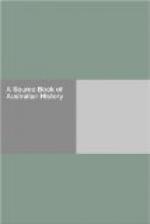The river itself is serpentine, the banks clothed with verdure to the water’s edge, their general height various, but seldom either more or less than eight or nine feet, inclined or precipitous, as they happen by the bending of the stream to be more or less exposed to the action of the current. On each side of the river is a perpetual succession of lagoons extending generally in length from one to two miles, and about a quarter of a mile in breadth. These, which are situate alternately on each side of the river, within those elbows and projections which are formed by its windings, often for miles together, preclude any approach to its banks. Each of these lagoons was furnished with an inlet from the river and an outlet into it.
In general, the spaces between the lagoons and the river are thickly wooded (the trees consisting principally of the blue gum of a large growth), and are overgrown with vines of various descriptions, and the fern, the peppermint, flax plant, and currajong. The fern, currajong, and the flax flourish here in abundance, and the peppermint plant (which they had not seen in any other part of the country) seems to surpass, both in odour and taste the species that is generally produced in our gardens.
From the flax-plant the natives, as they afterwards discover, make their fishing-lines and nets for carrying their travelling gear and provisions.
Unable to devise any means of crossing the river, and in hope of discovering some practicable ford, they now commence their progress down the stream, proceed three miles and a half, and then halt. At half-past two they resume their route, but are soon compelled from the continual succession of lagoon and swamp to return to some higher land, about two miles from the river.
[Crossing the river with difficulty, they travelled southwards for four weeks.]
Thursday, Dec. 16th.—This morning they cross the river or creek without difficulty, the water not taking the cattle more than chest high. They now proceed S.W. by S. through the plains about six miles, when they are struck with an appearance respecting which they cannot decide whether it is that of burning grass or of distant water.
They now therefore, having altered their course to the south, at four o’clock, have the gratification satisfactorily to determine, that the appearance which had just created so much doubt is that of the latter object, and which leaving the river a short distance, and directing their march from S.W. to SS.W. they soon ascertain to be part of the sea—the so long and ardently desired bourn of their labours. They now again alter their course to south-west and travel six miles in that direction along the shore, over excellent land, but clear of timber. On the downs, or plains to-day they had seen several flocks of emus and wild turkeys. The water near the shore was covered with waterfowl of various descriptions, some of which were new to them, and by the time they had halted for the night, they had procured an ample supply of black swans and ducks. They stopped for the night at seven o’clock in a small wood, at a mile from the beach, but where there was no fresh water, having travelled to-day, they supposed, upwards of twenty miles.




